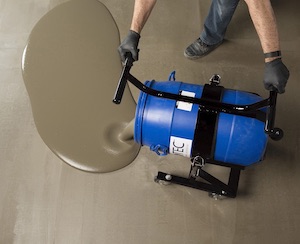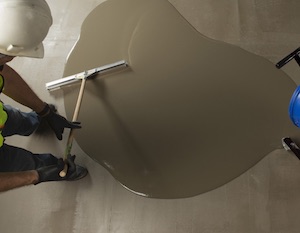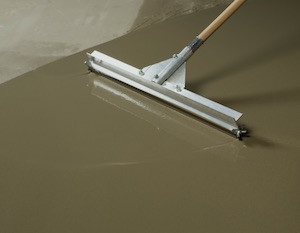“Self-leveling underlayment” is a bit of a misnomer because it requires the intervention of a thoughtful installer to ensure the best results. Follow these guidelines to prevent issues in your self-leveling underlayment installation.
1. Select a product appropriate for the installation: Know your installation environment and familiarize yourself with the relevant ASTM standards for strength. A commercial floor subject to heavy rolling loads will require a higher-grade self-leveling underlayment than a floor in a single-family home.
Also, it is critical to understand your project timeline and choose a product that fits within the appropriate schedule. Some products may require 24-48 hours prior to installing tile, while other more premium products are ready to accept flooring in as little as 2-4 hours. Consult product data sheets for information on tensile strength, compressive strength and flexural strength, as well as recommended cure times.
2. Stabilize your substrate: Most products require that all surfaces are fully stable and structurally sound prior to the application of a self-leveling underlayment. For example, wood must be securely fastened with screw-type or ring-shank nails and adhesive because if it shifts, it could cause cracking.
3. Prepare your substrate: Make sure to plug all floor openings, gaps and cracks and install termination dams to prevent any seepage. Consult with product manufacturers to determine moisture limitations of the self-leveler, adhesive and flooring to determine if moisture mitigation is needed.
If moisture mitigation is required, this must be done prior to installation of the self-leveling underlayment.


Self-leveling underlayments (SLUs) require the use of a primer prior to installation. Primer retains the moisture within the self-leveling underlayment to properly cure. Secondarily, it acts as a bonding agent to ensure the SLU bonds properly to the substrate. Refer to the primer label for information regarding application methods and dilution per ASTM F3191.
Beyond priming, most self-leveling underlayments require that the substrate be free from any contaminants that may inhibit bond, including oil, grease, dust, loose or peeling paint, sealers, floor finishes, curing compounds or contaminants. Some underlayments will require a certain concrete surface profile (CSP), and in these cases, mechanical abrasion, like shot-blasting, is required. Make sure the substrate is contaminant free and has the necessary surface profile before starting the pour.
4. Mix properly: Mix your self-leveling underlayment within the water range specified on the bag. Overwatering will lower the strength of the underlayment and can cause cracking and pinholing. Additionally, a white film (efflorescence) may form on the surface of the cured underlayment if the product is overwatered. This film can act as a bond breaker if the mortar bonds to the salts instead of the SLU. Do not over mix it, as this can make it harder to work with and lead to cracking or improper flow. Mix a maximum of two bags at a time when barrel mixing to ensure a proper blend. Follow equipment and product manufacturer’s recommendations when pumping self-leveler.


5. Be aware of product and environment temperature: Make sure that the temperature of the room is within the manufacturer’s acceptable range. A climate that is too cold or too hot can cause issues, such as increased set time in cool temperatures or reduction in heal time in hot environments. Temperature and humidity will affect flow, working time and set time.
Additionally, the temperature of the powder and the water is crucial. Leaving product in the sun, or in a hot environment may lead to flash setting. In situations where warm product is unavoidable, mixing with cool water may help combat installation issues.
Whether the environment is warm or cool, acclimating the product prior to mixing is a best practice.


6. Use as recommended: Manu-facturers will specify the maximum thickness of their product. Some products allow for addition of aggregate to increase the depth of the pour, while others only allow their product to be used neat. Be sure to use the appropriate aggregate size and amount when extending a self-leveling underlayment. If a surface is extremely uneven in an isolated area, a patch may be necessary, rather than a self-leveling underlayment. Consult with manufacturers to determine the most suitable product for your application.
Protect from excessive drying due to air movement. Use of fans or other direct air flow is not recommended, as the surface can be prematurely dried, leading to a weak underlayment.
7. Protect your underlayment: Generally, underlayments are not final wear surfaces. They should be protected from construction trade traffic until final floor covering is applied. Traffic without protection can lead to cracking and disbonding. Do not allow heavy or sharp metal objects to be dragged directly across the surface.
A common theme connects these recommendations: noting and adhering to the manufacturer’s instructions. You must read labels and product data sheets carefully to ensure products perform as desired. If you do have questions, you can always reach out to the product manufacturer.


Emily Brunner
Emily Brunner is an Area Technical Specialist for H.B. Fuller Construction Products covering the southern United States. Brunner works with application techniques training and troubleshooting for surface preparation, tile setting, and flooring adhesives.







